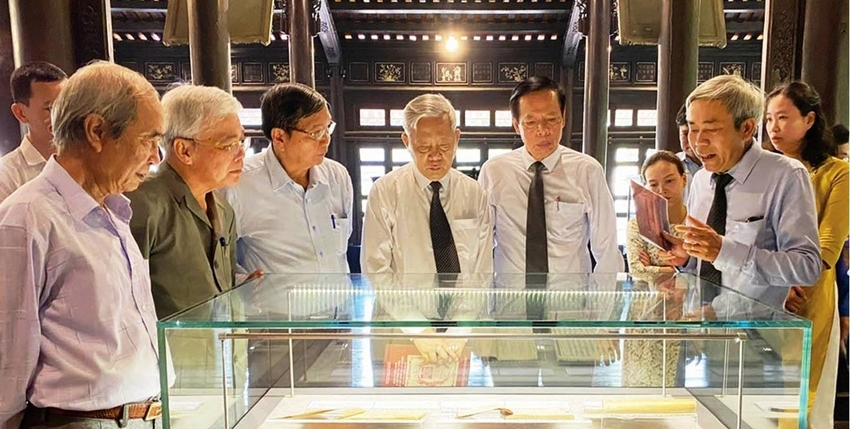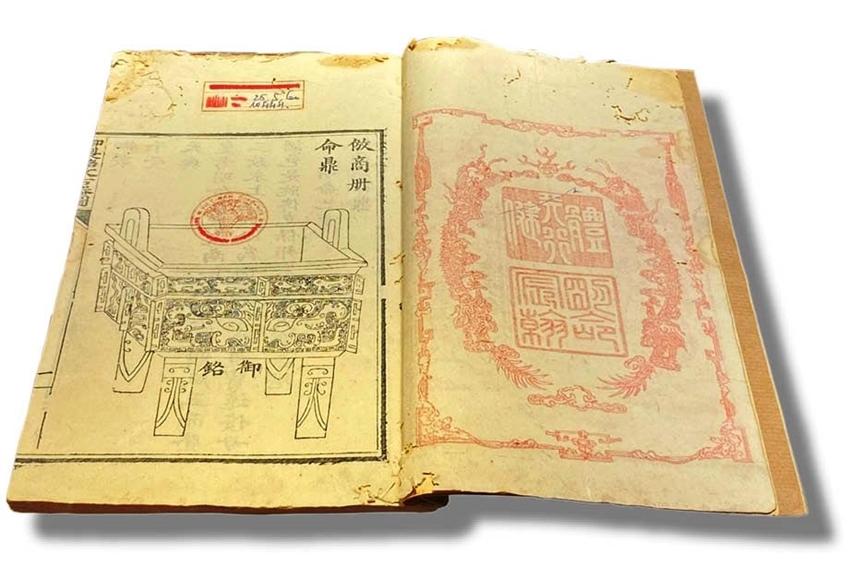    |
 |
| Ancient books being exhibited at Hue Museum of Royal Antiquities |
Valuable ancient books
This year, on the occasion of Vietnam Books and Reading Culture Day, Hue Monuments Conservation Center (HMCC) has introduced to the public a wide range of artifacts under the Nguyen Dynasty, such as ancient books, official documents and written bestowal of noble titles. These were donated to Hue Museum of Royal Antiquities (HMRA) from 2008 to the present by individuals and organizations.
Among these donated items are 11 ancient books which were collected by Mr. Hoang Viet Trung, Director of the HMCC, and donated to the HMRA. These are valuable works, such as: “Tự Đức thánh chế tự học giải nghĩa ca” (Vol. 7), “Tự Đức thánh chế thi tam tập” (Tu Duc’s Book Of Poetry), “Đại Nam thực lục chính biên đệ tứ kỷ” (vol. 69), “Giao tự đại lễ”, ‘Nghi thức thuyết giới Bồ tát tại gia”, “Điền tô sai dư thuế lệ”, “Truyện thơ Nôm Phan Trần”, “Chinh Phụ Ngâm”... together with illustrated books of the early 20th century, of which the most precious is "Ngự chế minh văn cổ khí đồ” composed by Emperor Minh Mang”.
The exhibition also introduces ancient books donated by other individuals, such as the book “Emperor Minh Mang’s Poetic Records in Six Volumes", which is a collection of 39 poems of Emperor Minh Mang, donated in 2008 by Andue de Cuozet, a former judge living in Marseille (France); 4 “Land Records” books donated in 2010 by Mr. Le Gia from Hue city; the book “Technologies of the Annamites” donated in 2013 by Ms. Bui Cam Ha Le Thai (a Vietnamese expat from France); 7 written bestowal of noble titles and official decrees donated in 2023 by Mr. Nguyen Phuoc Vinh Huot from Hue city; a six-volume Chinese dictionary, and the book “Classical Prose Edited and Annotated” donated in 2023 by the scholar Tran Duc Anh Son.
These ancient documents are valuable not only in terms of the information they provide, but also in terms of aesthetics. For example, “Giao tự đại lễ” is an impressive hand-written manuscript produced by the Ministry of Rites, in order to determine the placement of the tablets and offerings on each altar at the round upper altar and the square lower altar during the Nam Giao sacrificial ceremony. In addition, the HMRA also introduces to the public the artifacts in the museum’s own collection, such as books and the royal calendars.
    |
 |
| The book “Ngự chế minh văn cổ khí đồ” Composed by Emperor Minh Mang |
Of interest to many people is the book “Ngự chế minh văn cổ khí đồ” composed by Emperor Minh Mang”, which is one of the few still in archive despite being just a printed version. According to Mr. Nguyen Phuoc Hai Trung, Deputy Director of the HMCC, there are currently only two known printed copies of this book: one (coded EFEC.VIET/A/ART/1) stored at the Library of Paris in France and another stored at the Library of the Institute of Han-Nom Studies (coded A.147). Thus, the copy of “Ngự chế minh văn cổ khí đồ composed by Emperor Minh Mang” donated and displayed at the HMRA is the third known version.
The collection of ancient books
The scholar Nguyen Xuan Hoa believed that ancient books under the Nguyen Dynasty are also ancient books of our country, since the Nguyen Dynasty was the last monarchy. The Nguyen Dynasty not only edited and published books at the time but also collected ancient books of the previous dynasties. Therefore, it is very important to continue to collect, preserve, display and introduce to the public these ancient documents. It is meant to raise people's awareness of the value of our Chinese- Vietnamese Demotic characters (Han Nom) heritage, because, previously, people were only interested in antiquities instead of rare books and documents. The donation of valuable rare books is the first step for the HMRA to collect such things.
“Many families still keep ancient books and documents under the Nguyen Dynasty as a treasure. If there is a clear policy, it is possible to encourage them to hand them over to the HMRA for proper preservation and public display. Moreover, it is time to select some valuable works to research, translate and publish to keep the public well inform of the cultural values of the Nguyen Dynasty, "said Mr. Hoa.
Since 1923, when establishing Musee Khai Dinh (which is now the HMRA), Emperor Khai Dinh issued an edict calling on individuals in the country to donate antique artifacts to this museum. Over the last 20 years, that tradition of preserving antique artifacts has continued, thanks to those interested in preserving cultural heritage. In the past years, the HMCC and the HMRA have done a good job of mobilizing organizations and individuals to donate antiquities and rare books to the museum.
Mr. Hai Trung, Vice the director of HMCC, said that apart from antiquities, books and written documents are stored in private collections, and scattered in Hue and the neighboring regions. This is because although many people want to donate, they do not know of a reliable recipient. Therefore, it is necessary to promote Hue culture by means of ancient books. “Museums must build trust so that people will feel confident about putting ancient books to the museums’ good hands," Mr. Trung emphasized.
